Nowadays, the Solana developer ecosystem has more than 2500 monthly active open source developers, and professional developers continue to join the ecosystem, making the developer environment increasingly mature.
Original Title: "The 2023 State of the Solana Developer Ecosystem"
Written by: Solana Foundation
Translated by: 0x711, BlockBeats
The Solana developer ecosystem continues to grow. In 2023, the ecosystem made significant progress in tools, developer experience, content quality, and diversity of available programming languages. Nowadays, the Solana developer ecosystem has more than 2500 monthly active open source developers, and professional developers continue to join the ecosystem, making the developer environment increasingly mature.
Developer Ecosystem
The health of a blockchain's developer ecosystem is crucial for maintaining the network. While measuring the health of an ecosystem is challenging and no single factor can tell the whole story, the following indicators are crucial for evaluation:
- Total number of monthly active open source developers: Developers actively building within the ecosystem each month.
- Developer retention rate: Nurturing sustained development within the ecosystem.
- Developer experience level: Professional experience of developers.
- Developer growth: Number of developers entering the ecosystem at any given time.
Total Number of Monthly Active Developers
One of the simplest ways to measure how a network is growing is by the number of active developers on the blockchain. At the Solana Foundation, we use an open-source service to collect developer data and have publicly documented how we collect this data. Over the past year, we have had approximately 2500-3000 developers consistently active on Solana throughout 2023.
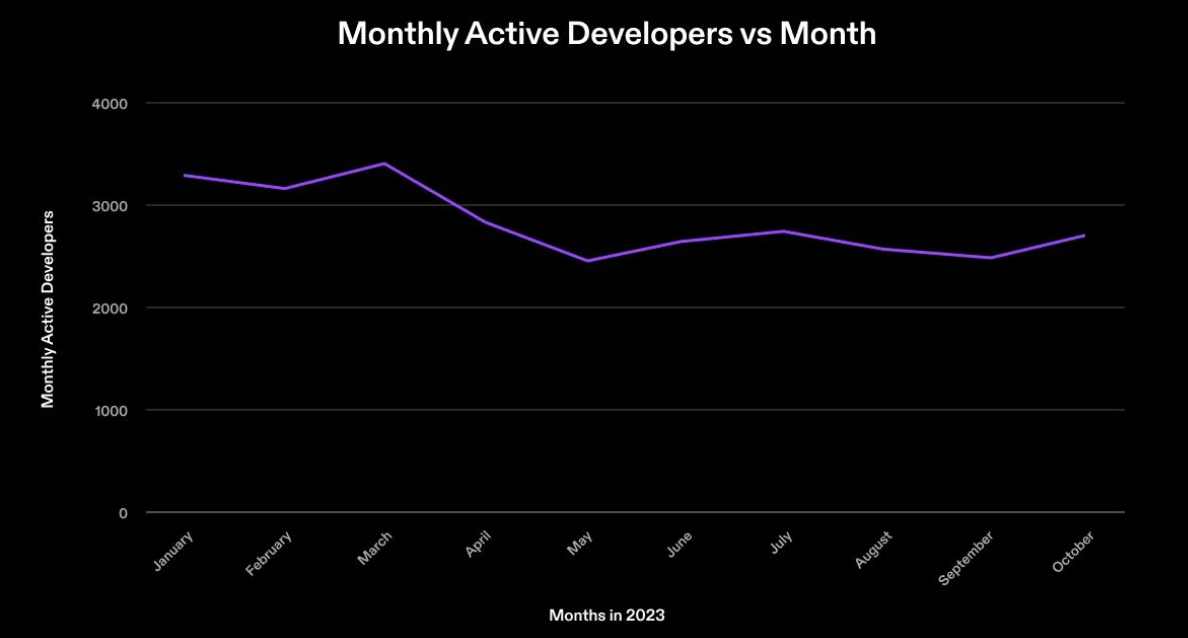
2023 Monthly Developer Activity Data
Maintaining a certain number of developers is an important indicator of a healthy ecosystem, as it demonstrates the ecosystem's ability to attract and retain new talent. It is important to note that this data only accounts for developers contributing to public repositories and does not consider developer activity occurring in personal repositories. This may result in an underestimation of the number of active developers at specific points in time. The Solana Foundation is committed to supporting the growth of the open-source community on the Solana blockchain, and the Foundation's continued support for public development will help drive future innovation in Solana applications.
Developer Retention Rate
Measuring the number of monthly active developers is only part of the story. A large number of experimental blockchain developers with low retention rates may not translate into a sustainable developer community. Low retention rates pose a risk and may lead to developers leaving before making meaningful contributions to the network. To further assess the health of the developer community, it is crucial to measure retention rates in conjunction with the number of monthly active developers. For this report, a developer is defined as retained if they make at least one code commit in three consecutive months after starting.
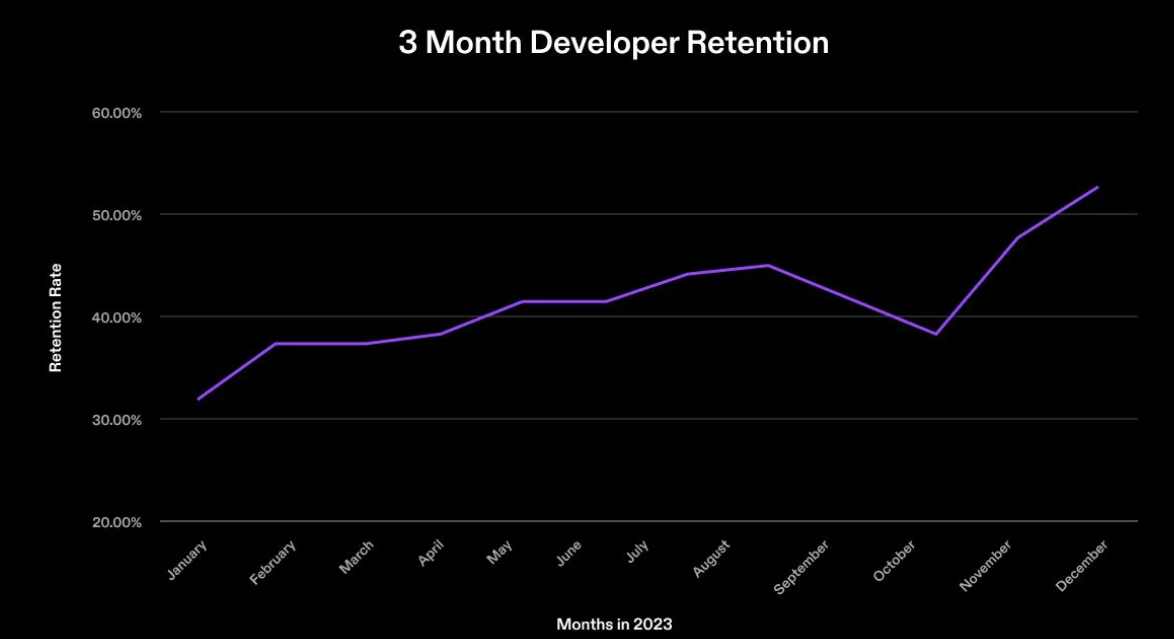
2023 Monthly Developer Retention Rate Data
In 2023, the 3-month developer retention rate in the Solana ecosystem increased from 31% to over 50%, resulting in more developers staying in the ecosystem. The increase in retention rate may be attributed to several reasons:
- Improvements in developer onboarding.
- Solana blockchain becoming a clearer choice for developers.
- Increased opportunities within the ecosystem.
Over the past year, the Solana Foundation has released multiple new guides on getting started, steadily improving the onboarding process for Solana developers. With various developer bootcamps focusing on different areas and levels of difficulty, 400-500 advanced developers graduate every 6 months with the intention of building on Solana. Data from the latest Solana Hyperdrive hackathon shows that approximately 50% of the top 150 submitters and 50% of the winners have completed at least one of these bootcamps. Teams within the ecosystem also heavily support building on Solana. For example, the Helius team published a blog explaining why developers should choose to build on Solana. While the opportunities provided to developers within the ecosystem are difficult to measure, the number of job postings on jobs.solana.com, a site that aggregates positions within the Solana ecosystem, has been steadily increasing, from 15 in January 2023 to 95 at the time of publication. 41 positions were added in December 2023 alone. While this is an imperfect metric, job opportunities are crucial for retaining new talent and building on the network.
Developer Experience Level
The skill level of developers building applications on the chain directly impacts the overall success of the network. If a network is primarily built by more experienced developers, the likelihood of its applications attracting new users is higher. Within the Solana ecosystem, over half of the developers entering the ecosystem have at least 3 years of experience, leading them to make more advanced contributions to applications built on the network. One way to measure this is by assessing the experience level of attendees at Solana's Hacker House events held globally. These events serve as spaces for learning and networking, with lectures and office hours specifically tailored to developers and founders. Among the 1059 developers who attended Solana Hacker House in 2023, 52.5% indicated they have over 3 years of developer experience, more than any other group in our events.
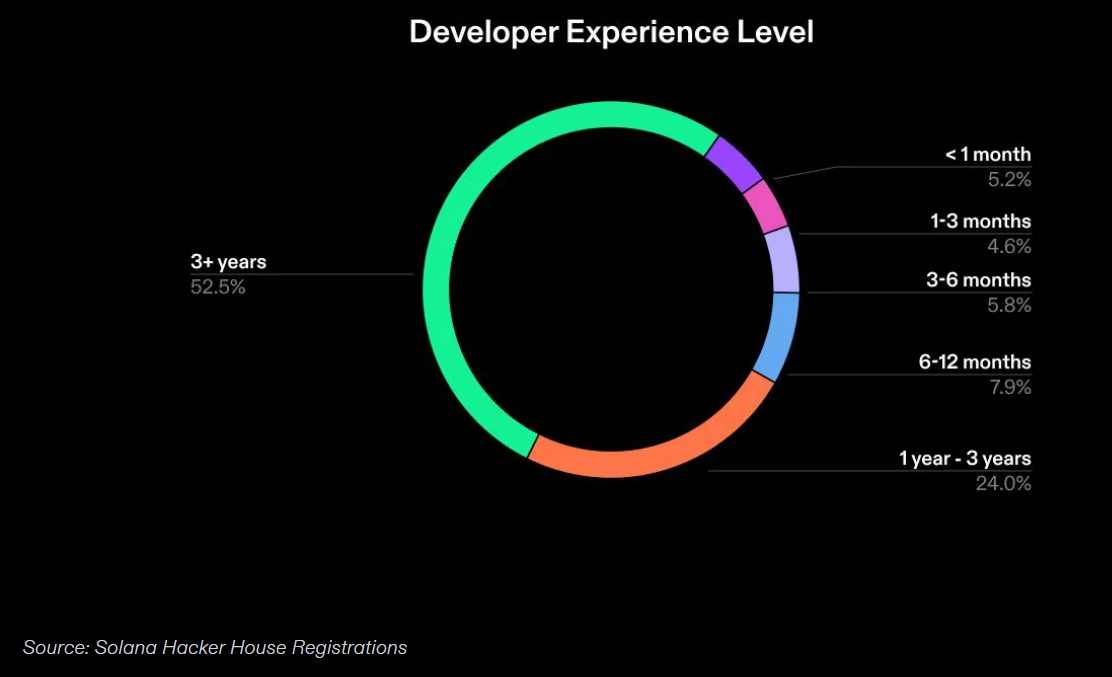
Developer Experience Level Data
Developer Growth
Although the Solana ecosystem is relatively new (the Solana mainnet test version was launched in March 2020), its developer ecosystem has grown to become the second largest ecosystem in terms of the total number of monthly active developers. This growth is attributed to many different factors, making it difficult to pinpoint what has led to the majority of developers joining. Since the launch of the mainnet test version, the Solana Foundation has initiated or sponsored various initiatives with the core goal of developing the developer ecosystem. Some key initiatives include Solana hackathons, Solana Hacker House, Breakpoint, educational bootcamps, and sponsored university activities. Ecosystem-led teams such as SuperteamDAO, mtnDao, Metcamp, and Gen3 have also contributed to this growth. We expect Solana hackathons to become a key indicator of the health of the developer ecosystem. Since 2020, the Solana Foundation has sponsored 8 hackathons. Over the past three years, over 3000 projects have been launched, raising over $600 million in funding for projects submitted to the hackathons. With each hackathon, the number of project submissions has been increasing. The recent "Solana Hyperdrive" hackathon received over 900 submissions.
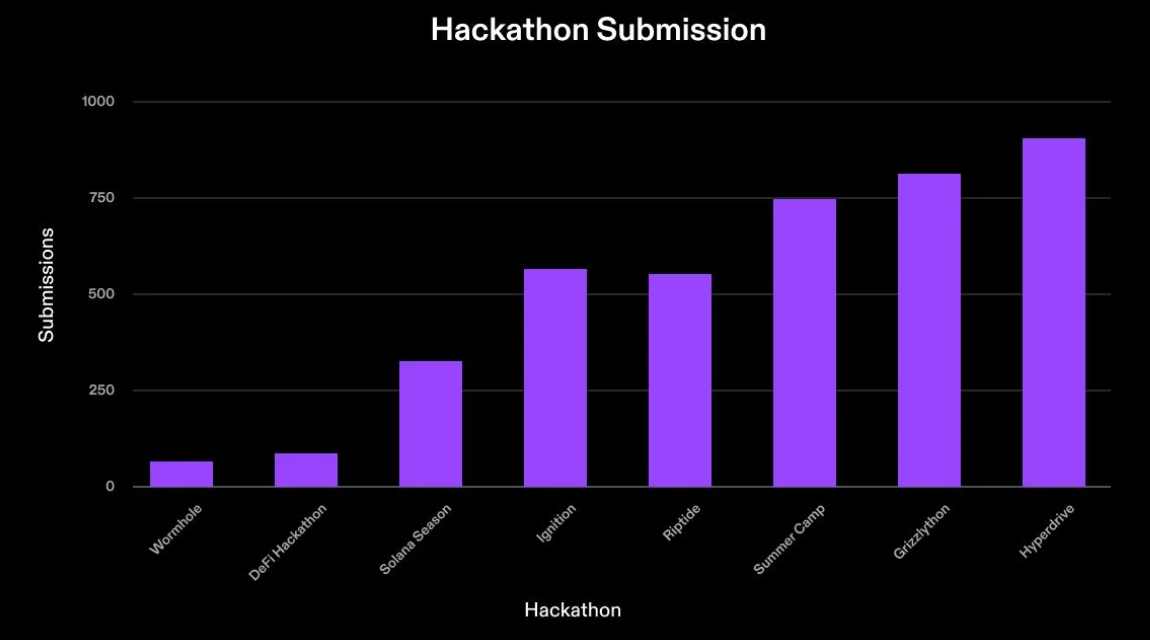
Hackathon Submission Count
Global Growth
It is important to note that while the entire ecosystem is growing, a significant portion of the growth comes from newly onboarded global regions. Efforts in the global developer ecosystem stem from a bottom-up community approach, expanding outward. An example is SuperteamDao, a builder community focused on India. SuperteamDao began expanding to other countries/regions in early 2023 and now has branches in 8 countries/regions. Other groups with a similar approach include Gen3 in Taiwan, MetacampDao in Singapore, and mtnDao in the United States. While the Solana Foundation currently does not track detailed regional growth on a daily basis, the growth rate can be seen at a regional level through the biannual Solana hackathons. In the recent "Solana Hyperdrive" hackathon, participants came from 151 countries, with 65 countries submitting final works.
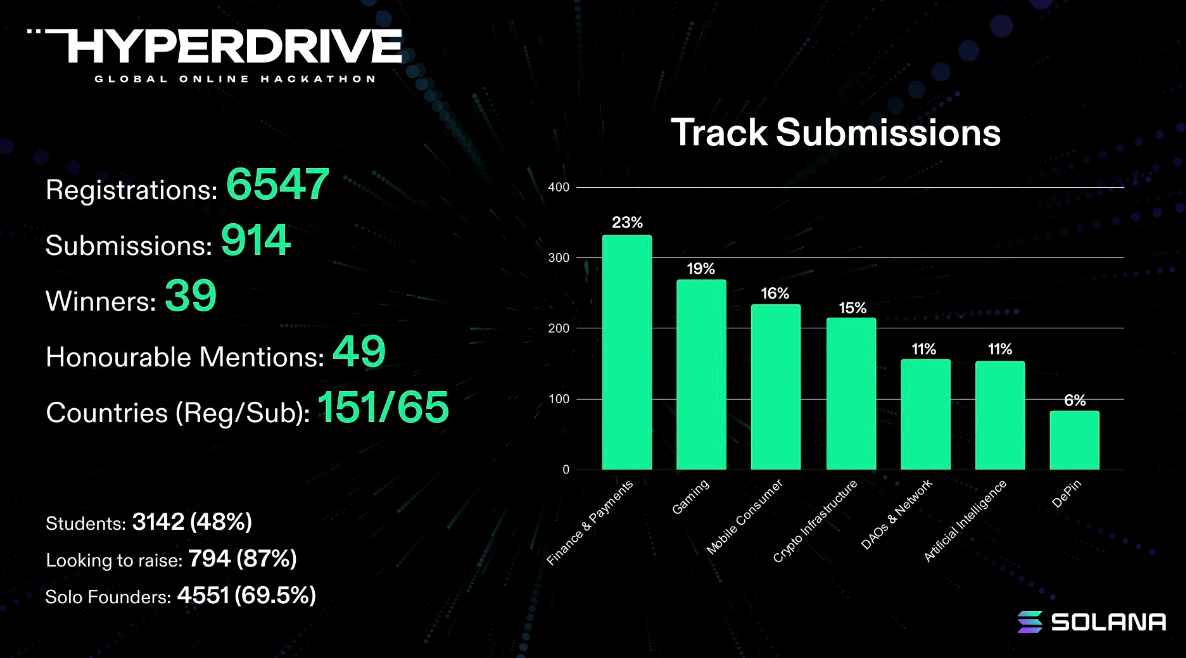
Historically, the United States has been the most represented country in Solana hackathons, followed closely by India. In recent years, the share of submissions from countries outside the United States has increased significantly, from 76% in 2021 to 91% in Hyperdrive. The developer community has been a priority focus for countries with deep engineering talent, such as India, Germany, China, the UK, Turkey, and Vietnam. Notable countries include Brazil and the entire Latin America, Japan, France, Nigeria, and Israel.
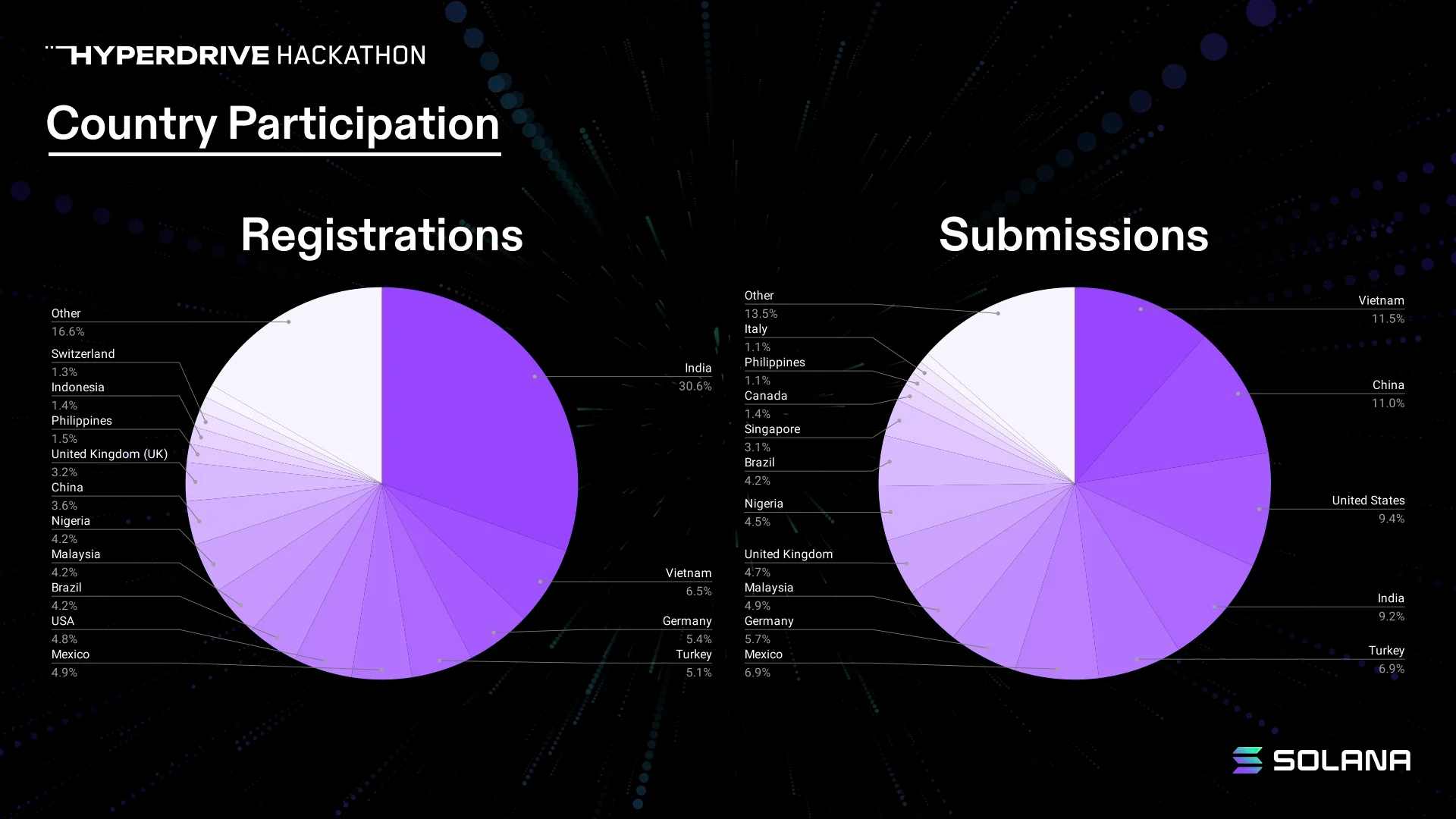
As the most mature region in the Solana ecosystem, the United States continues to dominate among hackathon winners, but these numbers continue to change. Ultimately, the goal of any developer ecosystem should be high-quality projects evenly distributed globally.
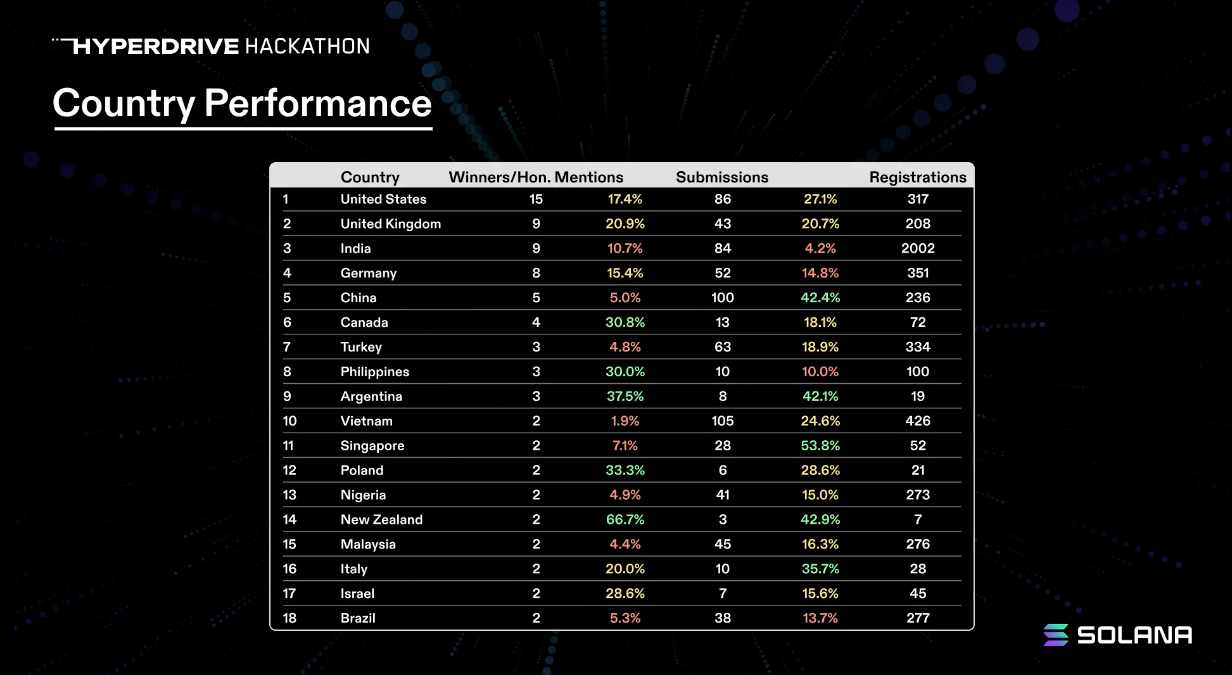
Building on Solana Today
The widespread adoption of blockchain depends on the availability of robust infrastructure and developer tools to achieve seamless onboarding and continuous development. When choosing an ecosystem to build on, developers consider several key factors:
- Developer experience: How easy is it to learn and build applications?
- Maintenance: How much effort is required to maintain and monitor applications being built? As the Solana ecosystem continues to evolve, it is expected that each area will mature and become more accessible to developers.
Developer Experience
Developer experience is a crucial part of any ecosystem—maturity of available resources and tools has a decisive impact on the developer's building process. Today, the Solana blockchain has a growingly mature tooling ecosystem and a wealth of resources for developer onboarding. Looking ahead, releasing more resources on building projects from start to finish can help accelerate new developers and aid in debugging and understanding computational resource usage tools. The Solana protocol is known for its parallel processing capabilities, which can only be achieved by requiring developers to declare the state parts they are using in advance. Therefore, developers need appropriate frameworks and tools to manage all states more easily. Developers deciding whether to build on Solana will ask the following questions:
- Documentation and examples: How easy is it to reference available documentation and resources?
- Educational programs and courses: What education is available to developers?
- SDKs and frameworks: Are there common SDKs and frameworks to accelerate my development?
- Local development tools: How flexible are the local tools for rapid prototyping of a new application?
- Tooling completeness: How does Solana compare to other ecosystems?
Documentation and Examples
Currently, documentation on the Solana blockchain is largely conceptual and includes guides to help developers get started building on Solana. Over the past year, a significant number of program examples have been created to help anyone build on Solana, contributing to the launch of the on-chain developer ecosystem. The Solana Cookbook features a comprehensive selection of client-side code examples, including hundreds of code snippets in at least three different programming languages. For developers looking to learn more about the latest internal knowledge of the Solana protocol, there is currently a lack of up-to-date information. This is partly due to the rapid pace of updates to the Solana protocol. Improvements to Solana's documentation and protocol specifications will gradually fill in the gaps by placing them in the documentation before implementation. As Solana continues to mature, more research organizations like Umbra Research are starting to write internal knowledge, and the latest information should become more widespread in the documentation.
Educational Programs and Courses
At the time of writing, there are various comprehensive educational programs and courses available to help developers enter the Solana ecosystem. These include self-paced courses and mentor-guided, community-based programs. The different structures of educational development programs help developers learn in their preferred way, maintain a high level of accountability, and increase the chances of success for participants. Self-paced educational programs and courses over the past 12 months include:
- Solana Unpack Course
- Freecodecamp
- EasyA - IdeaSoft
Additionally, some mentor-guided programs are:
- Web3BuildersAllianace
- Encode Club
- Ackee Blockchain
- Narr8ative
- Calyptus
- DevsNest
- RiseIn
- Nas Academy
SDKs and Frameworks
The Solana developer ecosystem has a solid foundation of SDKs that influence most developers. In terms of UI frameworks, there is a high concentration of React and Next.js tools on the Solana blockchain. For each language, we can evaluate the available tools in the following ways:
- Solana SDK: SDK for interacting with RPC and creating transactions to interact with the blockchain.
- Program frameworks: Functionality for creating Solana programs using specific programming languages.
- Developer influence: Measuring the percentage of developers using a programming language or UI framework.

New developers entering the ecosystem can now fully onboard to building on Solana by only writing Typescript (without learning Rust or writing Solana smart contracts). Furthermore, developers in different technical domains have new tools available. Game developers have feature-rich Unity SDK, Godot SDK, and Unreal Engine SDK. Fintech developers can quickly adopt Solana's speed through SolanaPay. Building on Solana is now easier than ever before.
UI Frameworks
Scaffold and wallet adapters provide convenience for the developer experience of each UI framework. Currently, the most supported frameworks are React and Next.js, covering a large number of developers.
- Scaffold: A tool that allows developers to quickly set up a template website.
- Wallet Adapter: A tool that facilitates easy integration with Solana wallets.

Local Development Environment
The local development environment is a collection of tools that enable developers to build on their local machines, accelerating development and reducing build costs. To build a new application, developers need to start building on their local computer. An efficient local development environment can significantly reduce the resistance developers encounter when building on a new framework. The primary local environment tool currently in use is the Solana Tool Suite. This suite allows developers to run test validators, send transactions, airdrop, deploy smart contracts, and run tests against the environment on their local machines. This tool enables developers to run applications in a production environment from start to finish. Compared to the mature Foundry toolchain for EVM, the Solana Tool Suite has the functionality to send transactions via CLI and easily replicate mainnet accounts, although the experience is not as straightforward. Pulling accounts is more manual than Foundry because Solana smart contracts are stateless, meaning users must collect or create state in many different places to run tests locally. Sending transactions is possible but not as simple as extending to any smart contract, as the Solana protocol gives users the choice of serialization when interacting with smart contracts, resulting in many different interaction methods without a direct standard. Both of these are solvable in the long run.
Balance with Other Ecosystem Toolchains
One way to measure the availability of the Solana ecosystem toolchain is to compare it with popular tools outside of the EVM. In most cases, developers who are new to web3 and smart contracts will learn Solidity as their first language and EVM programming paradigm. This initial exposure to EVM complicates the transition to the Solana ecosystem for developers in the future, as it often requires developers to forget what they know about EVM in order to properly develop using the Solana protocol's account model. Among 5800 active Solidity developers per month, only 7% have tried Solana development. Some tools already exist to help accelerate the adoption of the Solana blockchain and the transition of developers from EVM. The following projects enable Solidity development:
- Neon: EVM-compatible development environment
- Hyperledger Solang: Solidity compiler on Solana
In addition to EVM-compatible environments, many developers may use native Solana development practices. For most major tools available in the EVM ecosystem, there is a Solana equivalent:
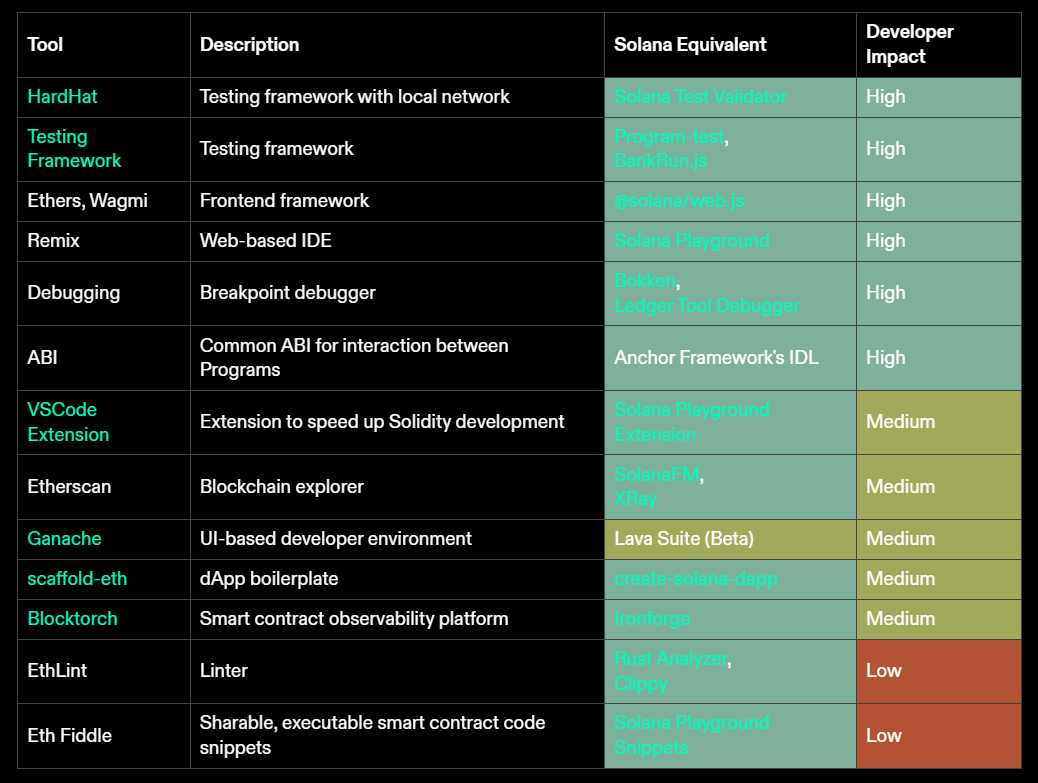
Given the relative newness of the Solana blockchain compared to EVM, this demonstrates that the developer ecosystem is building all the necessary tools to improve the Solana developer experience. While not yet meeting all the standards of Foundry, the Solana ecosystem is in a favorable position to further improve and mature its toolchain.
Maintenance
Any developer deploying an application to a production environment knows that being able to maintain the application easily will avoid a lot of trouble. How does the Solana protocol perform in maintaining applications? Understanding the ease of maintaining an application depends on several factors:
- Testing and debugging: How easy is it to write tests to maintain functionality and debug potential issues?
- Security: How to keep the application secure?
- Analytics: How to properly monitor the application's performance in a production environment?
Testing and Debugging
Testing and debugging are crucial in the development lifecycle. Tools related to testing and debugging can save hours of software development time, helping companies find issues faster and reducing risks during development. In 2023, the developer ecosystem built tools to make testing and debugging a simpler process.
- Debugger: Two methods using a step debugger were created in the past year, Bokken and ledger-tool debugger. With these tools, you can set breakpoints at every line of code in a basic Solana smart contract and understand the account state at each line of code.
- Testing: Mocha tests from the Anchor framework are currently the most commonly used testing framework in Solana smart contracts. In the past six months, Solana Bankrun was created to significantly speed up testing and make testing more powerful. Solana-program-test also exists, with similar functionality and speed.
- Code coverage: Code coverage tools for smart contracts on Solana are still incomplete. Developers can use general Rust code coverage tools, but most cannot accurately measure coverage.
- Logging: In most cases, the basic Solana logger used in solana-program. This logger can be accessed through smart contract logs and transmitted through Geyser or sologger for analysis. SaaS tools like Ironforge can also help monitor application logs in production. In the past year, the basic logger was improved through the Anchor framework, avoiding many early limitations.
- Events: The Anchor framework currently provides a very basic way of handling events for Solana on-chain applications. However, the framework does not provide you with an immediate event queue without some infrastructure and cannot keep up with the latest state of the chain without additional infrastructure. There are some future proposals around improving events on Solana.
Security
Having a secure application in production is crucial for any company looking to operate securely. Security in decentralized applications is even more critical. Any vulnerabilities in smart contracts could lead to significant financial losses if not careful. So how do today's developers keep their smart contracts secure?
- CI scanning: Developers can use basic Github actions scans to quickly identify minor vulnerabilities in smart contracts before any deployment.
- Audits: Any serious smart contract developer will have audits conducted by third-party companies within the ecosystem. In the short few years of Solana development, several companies focusing on audits have emerged.
- Fuzz testing: Proper fuzz testing for common known vulnerabilities is a good way to keep smart contracts secure. Fuzz testing frameworks like trdelnik provide a quick way to understand if smart contracts are susceptible to simple threats.
- Real-time scanning: Actively preventing any potential threats by scanning transactions for anomalies in real-time while in production is the best approach. Riverguard provides high-level scanning on the mainnet, understanding if on-chain applications are susceptible to attacks through a series of transaction patterns.
The Solana developer ecosystem has a considerable number of tools to keep on-chain applications running securely in production. However, as developer skill levels improve, more complex attacks are also increasing - we need to continue improving applications, further advancing security education and tools for success.
Analytics
Developers seek analytics about their application's performance and the performance of competitor applications. Currently, analytics platforms support Solana through raw and parsed transaction data. Due to the availability and depth of data in IDL, analytics platforms are slowing down and unable to provide rich account analysis. Once the IDL framework provided by Anchor is improved and more widely available, smart contract analytics will also improve.
Future Opportunities
The Solana developer ecosystem is only four years old. In this time, rich content and tools to help developers build have nurtured the increasingly mature ecosystem today. There are still many opportunities within the ecosystem. In the future, the developer ecosystem must further improve the local development environment to match the first-class tools provided by Foundry; add a more robust event system; and provide more end-to-end product examples to accelerate the development of new applications. The Solana Foundation has been working to help grow the Solana developer ecosystem, encouraging new developers to contribute to the developer experience and supporting the maturity of tools. If you have ideas to improve the Solana developer ecosystem and need financial support, feel free to apply for funding at any time. We welcome any feedback on the developer ecosystem and how to improve the experience.
免责声明:本文章仅代表作者个人观点,不代表本平台的立场和观点。本文章仅供信息分享,不构成对任何人的任何投资建议。用户与作者之间的任何争议,与本平台无关。如网页中刊载的文章或图片涉及侵权,请提供相关的权利证明和身份证明发送邮件到support@aicoin.com,本平台相关工作人员将会进行核查。




